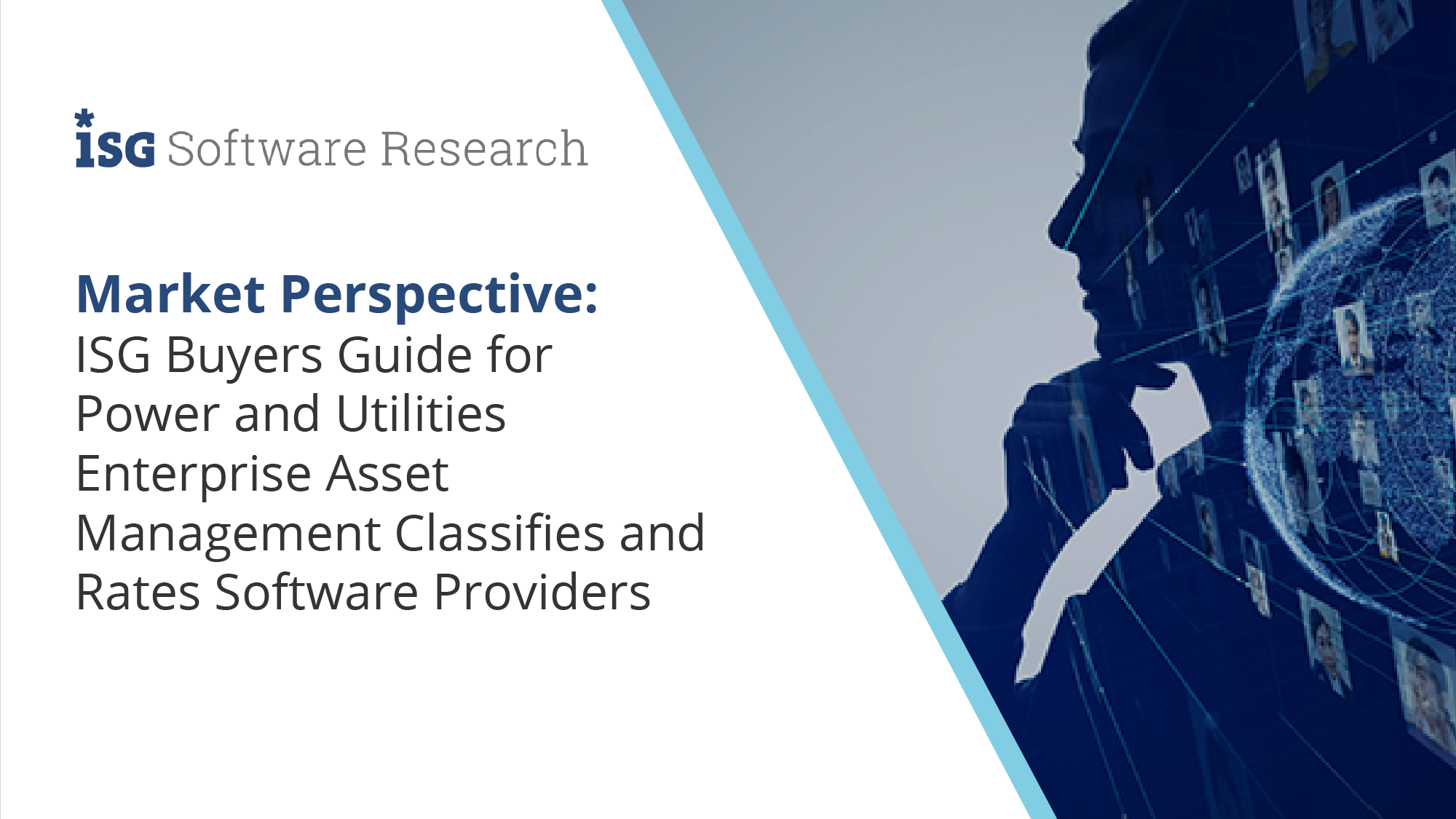Play audio
ISG Research is happy to share insights gleaned from our latest Buyers Guide, an assessment of how well software providers’ offerings meet buyers’ requirements. The Power and Utilities Enterprise Asset Management: ISG Research Buyers Guide is the distillation of a year of market and product research by ISG Research.
The global population is projected to reach 9.7 billion by 2050, from 8 billion in 2023, fueling efforts to meet growing energy needs. The demand for all types of energy sources—including  traditional fossil fuels such as coal, oil and natural gas, along with nuclear and renewable sources like solar, wind and hydropower—has introduced a spectrum of innovative energy-delivery technology that must be continuously operated and governed. Now intertwined with governments, the public and the private sector, these systems require physical and digital protection to ensure the continuity of power and utilities everywhere on the planet.
traditional fossil fuels such as coal, oil and natural gas, along with nuclear and renewable sources like solar, wind and hydropower—has introduced a spectrum of innovative energy-delivery technology that must be continuously operated and governed. Now intertwined with governments, the public and the private sector, these systems require physical and digital protection to ensure the continuity of power and utilities everywhere on the planet.
Global trends are changing how regions and countries transform energy infrastructure. Impacts include the steadily increasing demand for renewable energy and sustainability, government regulations, the development of smart cities, geopolitical situations and fossil fuel prices. The decarbonization and clean energy transition is driven by significant legislative support and investments to reduce emissions while maintaining market prices that support consumer and business economics.
This requires the power and utilities industry to keep pace with functional needs, such as:
- Focusing on grid transformation. For reliability and flexibility, especially in the face of increasing weather and climate-related challenges, advanced delivery mechanisms such as virtual power plants and microgrids are essential for supporting cleaner and more reliable energy sources.
- Managing supply chain resilience. Accessibility of critical components such as steel, aluminum and transformers is key to minimizing disruptions, developing domestic supply chains and reducing dependency on foreign materials.
- Incorporating clean and renewable energy sources. These energies are growing in utilization, creating new demand for technologies to support them and the intertwining of operations with traditional sources.
- Keeping pace with technology. Artificial intelligence and smart infrastructure with meters and grids play a significant role in the integration of centralized and alternative energy sources to ensure flexibility in meeting supply and demand.
The power and utilities industry is in a state of flux, with demand for electricity on the rise. Driven by economic growth and electrification trends, the path forward is peppered with challenges and opportunities. The clean energy transition is a major driver of renewables, particularly solar and wind, and is projected to surpass coal as the leading source of global electricity generation.
The grid, however, is struggling to keep pace with the changing energy landscape. Aging infrastructure, coupled with the integration of distributed energy resources like rooftop solar, presents reliability concerns. Transformation efforts are underway but require significant capital investment, which is further complicated by rising interest rates and cycles of inflation that impact the cost of fuel and resulting prices. Regulatory frameworks pressure the balance between ensuring grid resilience and keeping energy affordable.
The power and utilities industry relies heavily on a vast network of infrastructure and equipment, including power plants, substations, transmission lines and distribution grids. The technology to support power and utilities is always in operation, but in some ways also inevitably in crisis. Ensuring consumer consumption across traditional power grids and equipment requires continuous support.
Effective asset management in the utility industry is crucial for systematically planning, utilizing and maintaining physical assets such as turbines, transmission lines and transformers throughout the service life to ensure durability.  Implementing strong asset management practices leads to improved productivity, lower maintenance costs, enhanced equipment reliability and increased safety, helping enterprises maximize resource efficiency. Energy facilities that adopt comprehensive asset-management strategies for maintaining efficient, functional and environmentally friendly assets boost production efficiency substantively.
Implementing strong asset management practices leads to improved productivity, lower maintenance costs, enhanced equipment reliability and increased safety, helping enterprises maximize resource efficiency. Energy facilities that adopt comprehensive asset-management strategies for maintaining efficient, functional and environmentally friendly assets boost production efficiency substantively.
However, managing assets in the utility sector is complex and challenging due to the capital-intensive nature of the industry and factors like remote maintenance, underutilization, extended asset life cycles, limited expertise and environmental risks. Supporting the grid and expanded operations of the power and utilities industry requires enterprise asset management software, which delivers optimized asset performance, enhanced reliability, reduced costs and improved operational efficiency. Through 2027, over one-half of the power and utilities industry will update enterprise asset management systems to meet the need for continuity in operations across the energy supply chain.
EAM requirements have evolved to include innovations in operations and insights to support management and operators efficiently. ISG defines enterprise asset management in the power and utilities industry to support asset life cycle management, maintenance, repair and operations, labor management, controls management, application maintenance and support, supply chain applications, cloud services, asset health management, digital enablement services and remote monitoring. The software enables enterprises to increase asset performance, extend its useful life and reduce operational costs.
Enterprises assessing EAM software face many considerations, including how it supports the aging infrastructure and maintenance priorities required to ensure reliable performance, as well as the intricately complex and proprietary interconnected systems that make it difficult to isolate and address problems without adverse impacts. The environmental factors of climate change and extreme weather events affect the performance and lifespan of utility assets, increasing the need for resilient infrastructure. The wide variety of remote locations and challenging environments makes maintenance and inspections difficult and costly. Underutilization of assets and fluctuations in demand coupled with operational inefficiencies potentially increase costs and reduce return on investment. And the dwindling knowledge and expertise available increases the risk of not maintaining and repairing assets efficiently.
EAM software plays a vital role in maintaining the smooth and efficient operation of utilities for enhanced safety and compliance, maximized uptime and efficiency, optimized costs, an empowered workforce and improved decision-making. EAM software facilitates the comprehensive management and maintenance of assets from capital planning and procurement through installation, performance monitoring, maintenance, compliance, risk management and asset disposal.
The convergence of EAM with emerging technologies is driving innovation and value creation. Incorporating AI offers more intelligent and predictive maintenance and operations, furthering integration with IoT and cloud computing environments. Augmented reality and digital twin technology create virtual replicas of physical assets, enabling enterprises to simulate operations, predict disruptions and optimize maintenance for reduced downtime and extended asset lifespan. Mobile technology continues to evolve and support the entire life cycle of communications, scheduling and real-time updates from field service. And through the use of data, the consumption and relevant relationships to sustainability and carbon footprints are more easily managed.
Today’s EAM systems can enhance efficiency, streamline maintenance processes, reduce manual tasks and improve resource allocation. This enables substantial efficiencies and cost savings by optimizing asset utilization, minimizing downtime and reducing maintenance expenses. A further benefit is uninterrupted service delivery due to improved reliability through proactive maintenance and predictive analytics that identify potential failures before they occur. These systems also enable enhanced sustainability by tracking asset carbon footprints, optimizing energy consumption and identifying opportunities for renewable energy integration.
This ISG Buyers Guide evaluates software providers offering asset management systems for the power and utilities sector. Key features include asset health monitoring, predictive maintenance, work and labor management and supply chain optimization. Advanced functionalities like computerized maintenance management, geographic information, supervisory control, data acquisition and AI-driven analytics are essential. Integration with next-gen technologies such as automation, IoT, AI, cloud and blockchain is critical for enhancing operational efficiency and asset performance.
The ISG Buyers Guide™ for Power and Utilities Enterprise Asset Management evaluates products based on a capability framework that supports asset collaboration and management, device coordination, field service and preventative and predictive management. These core EAM capabilities are the foundation for today’s power and utilities industry.
This research evaluates the following software providers that offer products to address key elements of power and utilities EAM as we define it: AspenTech, AssetWorks, CGI, GE Vernova, Hexagon, Hitachi Energy, IBM, IFS, Landis+Gyr, Oracle, Ramco and SAP.
This research-based index evaluates the full business and information technology value of power and utilities enterprise asset management software offerings. We encourage you to learn more about our Buyers Guide and its effectiveness as a provider selection and RFI/RFP tool.
We urge organizations to do a thorough job of evaluating power and utilities enterprise asset management offerings in this Buyers Guide as both the results of our in-depth analysis of these software providers and as an evaluation methodology. The Buyers Guide can be used to evaluate existing suppliers, plus provides evaluation criteria for new projects. Using it can shorten the cycle time for an RFP and the definition of an RFI.
The Buyers Guide for Power and Utilities Enterprise Asset Management in 2024 finds SAP first on the list, followed by IBM and Hitachi Energy.
Software providers that rated in the top three of any category ﹘ including the product and customer experience dimensions ﹘ earn the designation of Leader.
The Leaders in Product Experience are:
- SAP.
- Oracle.
- IBM.
The Leaders in Customer Experience are:
- GE Vernova.
- IBM.
- SAP.
The Leaders across any of the seven categories are:
- IBM and SAP, which have achieved this rating in five of the seven categories.
- Hitachi Energy and Oracle in three categories.
- GE Vernova in two categories.
- AspenTech, CGI, Hexagon and IFS in one category.

The overall performance chart provides a visual representation of how providers rate across product and customer experience. Software providers with products scoring higher in a weighted rating of the five product experience categories place farther to the right. The combination of ratings for the two customer experience categories determines their placement on the vertical axis. As a result, providers that place closer to the upper-right are “exemplary” and rated higher than those closer to the lower-left and identified as providers of “merit.” Software providers that excelled at customer experience over product experience have an “assurance” rating, and those excelling instead in product experience have an “innovative” rating.
Note that close provider scores should not be taken to imply that the packages evaluated are functionally identical or equally well-suited for use by every enterprise or process. Although there is a high degree of commonality in how organizations handle power and utilities enterprise asset management, there are many idiosyncrasies and differences that can make one provider’s offering a better fit than another.
ISG Research has made every effort to encompass in this Buyers Guide the overall product and customer experience from our power and utilities enterprise asset management blueprint, which we believe reflects what a well-crafted RFP should contain. Even so, there may be additional areas that affect which software provider and products best fit an enterprise’s particular requirements. Therefore, while this research is complete as it stands, utilizing it in your own organizational context is critical to ensure that products deliver the highest level of support for your projects.
You can find more details on our community as well as on our expertise in the research for this Buyers Guide.
Fill out the form to continue reading.

